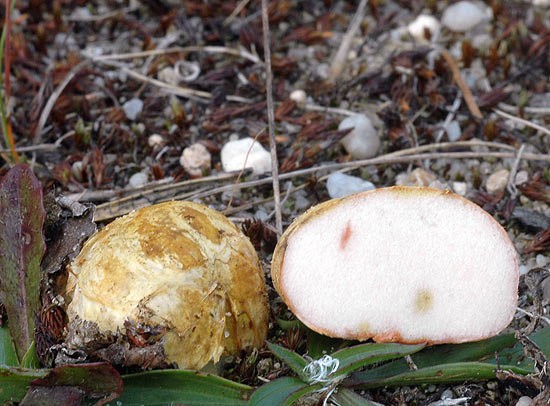rhizopogon ធម្មតា (Rhizopogon vulgaris)
- ផ្នែក៖ Basidiomycota (Basidiomycetes)
- ផ្នែករង៖ អាហ្គារីកូម៉ីកូទីណា (Agaricomycetes)
- ថ្នាក់៖ Agaricomycetes (Agaricomycetes)
- ប្រភេទរង៖ Agaricomycetidae (Agaricomycetes)
- លំដាប់: Boletales (Boletales)
- គ្រួសារ៖ Rhizopogonaceae (Rhizopogonaceae)
- ពូជ៖ រីហ្សូប៉ូហ្គុន (Rizopogon)
- ប្រភេទ: Rhizopogon vulgaris (common Rhizopogon)
- Truffle ordinary
- Truffle ordinary
- Rizopogon ordinary

The fruit bodies of Rhizopogon vulgaris are tuberous or round (irregular) in shape. at the same time, only single strands of fungal mycelium can be seen on the surface of the soil, while the main part of the fruiting body develops underground. The diameter of the described fungus varies from 1 to 5 cm. The surface of the common rhizopogon is characterized by a grayish-brown color. In mature, old mushrooms, the color of the fruiting body may change, becoming olive-brown, with a yellowish tint. In young mushrooms of ordinary rhizopogon, the surface to the touch is velvety, while in old ones it becomes smooth. The inner part of the mushroom has a high density, oily and thick. At first it has a light shade, but when the mushroom spores ripen, it becomes yellowish, sometimes brown-green.
The flesh of Rhizopogon vulgaris does not have any specific aroma and taste, it consists of a large number of special narrow chambers in which the spores of the fungus are located and ripen. The lower region of the fruiting body contains small roots called rhizomorphs. They are white.
Spores in the fungus Rhizopogon vulgaris are characterized by an elliptical shape and spindle-shaped structure, smooth, with a yellowish tinge. Along the edges of the spores, you can see a drop of oil.
Common rhizopogon (Rhizopogon vulgaris) is widely distributed in spruce, pine-oak and pine forests. You can sometimes find this mushroom in deciduous or mixed forests. It grows mainly under coniferous trees, pines and spruces. However, sometimes this type of mushroom can also be found under trees of other species (including deciduous ones). For its growth, the rhizopogon usually chooses soil or bedding from fallen leaves. It is not found too often, it grows on the surface of the soil, but more often it is deeply buried inside it. Active fruiting and an increase in the yield of an ordinary rhizopogon occurs from June to October. It is almost impossible to see single mushrooms of this species, since Rhizopogon vulgaris grows only in small groups.
Rhizopogon ordinary belongs to the number of little-studied mushrooms, but is considered edible. Mycologists recommend eating only the young fruiting bodies of Rhizopogon vulgaris.
The common rhizopogon (Rhizopogon vulgaris) is very similar in appearance to another mushroom from the same genus, called Rhizopogon roseolus (pinkish rhizopogon). True, in the latter, when damaged and strongly pressed, the flesh turns red, and the color of the outer surface of the fruiting body is white (in mature mushrooms it becomes olive-brown or yellowish).
The common rhizopogon has one interesting feature. Most of the fruiting body of this fungus develops underground, so it is often difficult for mushroom pickers to detect this variety.










